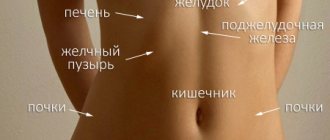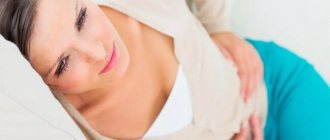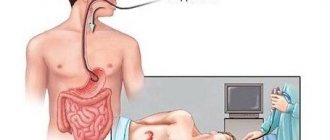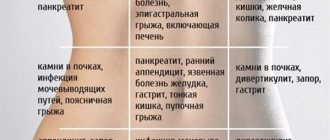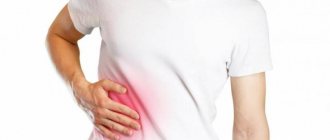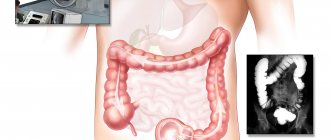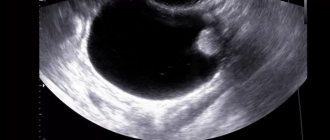If you are feeling unwell and trying to figure out why the lower abdomen hurts in women on the left, as well as what to do in this situation, read the article to the end. It contains all the information necessary for self-diagnosis and step-by-step instructions for further actions. It will help you not waste time and make an appointment immediately with the right specialist.
Causes of discomfort
You need to know: a woman has reproductive organs on the left side of her lower abdomen: the fallopian tubes, the left ovary (another name is the appendage) and the left region of the uterus. However, from the gastrointestinal tract organs located above them, discomfort sensations, radiating, can descend to the left iliac part.
They can be pulsating or single, be constant or periodic, and also occur only at certain times of the day.
There are many reasons for such pain:
- gynecological;
- problems of urology;
- neuralgic in nature;
- pregnancy;
- diseases of the endocrine system;
- gastrointestinal diseases;
- injuries, etc.
Therefore, you need to relax and try to determine the type of pain. Further diagnosis of unpleasant sensations largely depends on this.
What hurts on the left?
To know how to recover from pain, you need to understand where it hurts, how it hurts, and what exactly hurts. Very often, people complain to doctors that they have pain on the left side: either the stomach or the ribs, but the pain can be completely different.
If the pain is very strong and on the left, then you need to understand which part of the body exactly hurts - lower back, back, chest, stomach, etc. It is also advisable to decide what type of pain. It can be aching, squeezing, dagger-like, bursting, sharp. Any doctor you call will ask you to answer certain questions. First of all, you will be asked about when and how the pain on the left appeared: after exercise, nervous stress, suddenly or as a consequence of illness. You will also have to say how much time has passed since the pain began and whether the nature of the pain changed before the doctors arrived. You should also feel if the pain on the left is radiating somewhere else.
Upper left stomach hurts
There are certain organs in the left upper abdomen that can certainly be affected by something and cause pain. To determine what hurts you, you must know that on the upper left are the stomach, spleen, pancreas, diaphragm and parts of the intestines. In some diseases, the spleen enlarges, causing it to hurt. In addition, it may rupture, and then the pain will be even greater on the left, in addition, the skin around the navel will turn blue. If the intestines suffer, then in addition to pain in the left side of the abdomen, you will suffer from constipation or diarrhea, slight fever and bleeding when going to the toilet.
The stomach can also be the organ that hurts on the left if something irritates its mucous membrane. The cause may be alcohol consumption, strong antibiotics, too fatty and spicy foods. At the same time, the pain is quite weak, but aching and persistent. Vomiting and constant nausea occur frequently. A hernia may also hurt, and then the pain will radiate to the chest. Only an experienced doctor can diagnose a hernia, so it is better to immediately call a doctor or go to the hospital if you have severe pain of unknown origin in the abdomen.
The pancreas may also hurt on the left. At the same time, the temperature rises, the pain does not go away even with antibiotics, and vomiting also occurs. Pain in the pancreas is especially common in people who suffer from diabetes, smoke a lot, drink a lot, and simply lead an unhealthy lifestyle.
Lower left stomach hurts
Pain in the lower abdomen occurs quite often in both men and women. First of all, pain can be caused by inflammation, irritation, infection in the intestines (colitis, ulcers, diarrhea due to parasites), and compression of the nerves. If a stone creeps from the kidneys to the bladder, it can also cause severe and sharp pain in the lower abdomen on the left side. If a woman has so much pain in her lower left side that she cannot stand normally, such sharp and severe pain may be caused by a rupture from an ectopic pregnancy. This is the worst-case scenario, so you need to think about it first and check this assumption for other symptoms.
If a woman’s left lower abdomen begins to hurt during her period, then she may have endometriosis. Diseases such as nervous stomach are very common. These are pains that a person experiences during emotional stress, depression, or terrible news, due to which the nervous system malfunctions and begins to send incorrect signals to the brain. To get rid of such pain, it is enough to drink a sedative or remove the emotional factor that negatively affects your nervous system.
Nature of pain
To correctly diagnose the disease, the pain symptom must be correctly described and classified.
In order to independently accurately determine the nature of the pain, you need to renounce the painful state as much as possible and remember:
- have similar sensations occurred before;
- whether the type and location of pain have changed since then;
- what events usually precede the onset of illness (for example, physical activity or exposure to rain, etc.);
- what additional symptoms accompany the pain?
This will help to more accurately determine their origin and type.
The pain is dull, closer to aching
If the pain is tolerable, and the lower abdomen aches rather than tugs, then most often such sensations signal problems with the stomach or pancreas.
In this case, the malaise will be accompanied by additional symptoms:
- nausea and sometimes vomiting;
- subfibrile temperature (from 37 to 37.5).
The condition can be caused by eating provoking foods (for example, a lot of sweets at night, too fatty foods, especially when cold).
The cause of the malaise may be inflammation of the left ovary, or gynecological pathology of the uterus.
Then the clinical picture is usually supplemented by:
- discharge with blood from the vagina;
- a slight increase in temperature is possible.
If both ovaries are affected, the pain is floating, moving from left to right and back.
The source of dull pain in the lower abdomen can also be simple cystitis. In the chronic form, aching sensations are accompanied by:
- frequent urge to urinate;
- discomfort in the vaginal area.
You can relieve the condition by taking a hot bath.
In addition, aching pain in the left lower abdomen in a woman can be associated with tumor formations, varicose veins, bowel dysfunction, and inflammation of the hemorrhoidal vein.
Left-sided pain in the pelvic area can also be caused by a number of bone pathologies - postural deformation, fractures, inflammatory-destructive diseases of the spine.
Pulling sensations below
Mild nagging pain most often indicates an inflammatory process in the genitourinary system, which may be accompanied by:
- suppuration;
- pain that radiates to the lower back.
In this case, the pain may also go down to the left leg.
Irritable bowel syndrome, which has additional symptoms:
- constipation or diarrhea;
- bloating.
Often, with this ailment, spasmodic pain is superimposed on the pulling sensations in the lower abdomen.
Also, the cause of periodically occurring nagging pain may be a strangulated hernia or an inflamed area in the sigmoid or rectum.
Strangulated hernia
Pelvic neuralgia resulting from varicose veins, hernial formations, and pinched nerves. She is accompanied by:
- pain in the back or perineum, aggravated by physical activity;
- fast fatiguability.
Nagging pain in the lower back often appears after intense experiences and as a result of prolonged stressful situations.
Cutting pain, sharp colic on the left side
Sharp pain, intensifying with palpation to the point of excruciating pain, may be anatomically justified torsion of the leg of the myomatous node (although in the normal state, neoplasms with uterine or ovarian fibroids do not cause pain, or easily tolerated discomfort is felt).
This anomaly may have additional symptoms:
- disturbance of uterine bleeding;
- constipation;
- dizziness;
- infertility.
If this is accompanied by rapid heartbeat, profuse sweating and lightheadedness, then surgical intervention is urgently required.
An ectopic pregnancy is easy to recognize by general signs:
- breast enlargement;
- pain in the mammary glands;
- toxicosis (nausea, vomiting).
An abnormality is diagnosed on ultrasound.
Ovarian apoplexy (sudden rupture of the epididymal capsule), indicated by:
- sudden pallor;
- pressure drop;
- heart failure;
- general weakness;
- dizziness.
If you suspect apoplexy, you must immediately call an ambulance and wait for doctors, taking a horizontal position.
Acute left-sided pain can also be caused by the presence of infections such as dysentery, salmonellosis, gastroenteritis, or the presence of kidney stones or an attack of appendicitis.
Clinic for diseases of the genitourinary system
Women are often diagnosed with external endometriosis, in which pain occurs as myometrial cells grow.
If the ovaries are affected during this process, the symptoms of pain in the lower abdomen are similar to VD. If the left ovary is affected, the pain is aching, worsening before menstruation and during sex. At the same time, adhesions develop.
If the process is extended to the peritoneum, pain in the lower abdomen may be absent. When the fallopian tubes are affected, the syndrome manifests itself upon palpation of the uterus. Infertility and VB may develop.
If the pathology involves the cervix of the female reproductive organ, then the woman is bothered by persistent pain in the lower abdomen and uterus. The syndrome is associated with sexual intercourse and defecation.
The labia and vagina may be involved in the pathological process. The disease can be diagnosed visually by examining the patient.
Pain appears on palpation. At the same time, the woman cannot have sex, as the lower abdomen is very bothersome.
If during the examination the gynecologist reveals endometriotic nodules, it is recommended to undergo a comprehensive examination.
This condition can cause dangerous complications. As the nodules grow, a nagging pain appears in the lower abdomen and uterus.
If other symptoms appear against the background of the symptom in question, it is not recommended to postpone a visit to the doctor. When one pain syndrome manifests itself, a latent course of pathology is allowed.
In this case, instrumental and laboratory research is indicated. If the syndrome is accompanied by another clinic, differential diagnosis is indicated.
The diseases described above and the accompanying pain syndrome can be prevented by following the recommendations of doctors.
You need to lead an active life with moderate exercise every day. At the same time, proper rest and healthy eating are shown.
Diagnostics
In order to accurately determine the cause of the pain, you need to undergo a comprehensive examination prescribed by a specialist.
Typically it includes:
- Examination by a doctor (palpation and questioning of the patient).
- A general blood test (will show the presence of inflammatory processes in the body), laboratory urine analysis (required for urological problems).
- Ultrasound of the organ causing complaints.
- Additional methods: tests of liver and pancreatic enzymes, as well as radiographic and endoscopic studies.
Based on the results of the examination, an individual scheme of therapeutic measures is developed for each patient.
Treatment of pain in the intestines on the right and left lower abdomen
To determine the cause of severe pain in the intestines on the left and right side of the lower abdomen, the patient should visit a doctor. After the initial examination and consultation, the patient will be sent for testing. A general analysis of blood, urine and feces will show the internal indicators of the body and demonstrate the presence of any abnormalities in the systems of the human body.
For clearer results, the patient is referred for a bacteriological examination of stool, colonoscopy and endoscopic examination. After receiving the test results, the attending physician prescribes treatment for the patient. A medical expert prescribes medication, homeopathic or surgical intervention in advanced cases.
If necessary, to obtain information about the condition of the internal organs, the doctor refers the patient to undergo a computed tomography or ultrasound scan. These diagnostic tests are not recommended for pregnant women, nursing mothers, and children under sixteen years of age. Health care professionals do not recommend these procedures for certain groups of the population. The use of radiation and contrast fluid can negatively affect healthy organs.
To make an appointment for a consultation or examination at the private clinic “KDS Clinic”, leave a request on the website and managers will contact you as soon as possible.
Step-by-step instructions in case of left-sided pain in the lower abdomen
Ignoring pain on the left side in the lower abdomen can be simply dangerous, because there is a pathologist who requires immediate hospitalization, so simply taking a painkiller pill is not enough, because the cause of the ailment will remain.
I propose to proceed according to the following plan:
- Lie in the most comfortable position to reduce pain.
- Remember about existing chronic diseases and conditions (cystitis, pregnancy).
- Analyze the symptoms accompanying the current condition (dizziness, vomiting, etc.).
- If the pain occurs for the first time and gradually only intensifies, it is better to call an ambulance.
- When the pain is not severe, does not have serious accompanying symptoms and is not isolated in nature, then calling a doctor at home can be postponed, but it is still worth visiting the clinic in the near future.
- If pain persists for the second (or third!) day in a row, then it is better to hurry up with a visit to the doctor.
It is important to remember: even mild pain can be a sign of a serious complication.
How to identify constipation: symptoms
Another reason that causes pain on the right or left side of the lower abdomen may be the accumulation of hard feces in the intestines, which leads to constipation.
The main symptoms of constipation are:
- increased gas formation;
- feeling of fullness in the intestines;
- urge to defecate;
- bloating;
- no bowel movements were performed for 2-7 days.
The causes of constipation vary, but most often it is associated with poor diet, untimely bowel movements, or the use of certain medications.
also indicate the onset of diseases such as irritable bowel syndrome and diverticulitis.
(inflammation of pouches on the walls of the large intestine called diverticula). But such diseases often, in addition to pain, also exhibit other symptoms - diarrhea, fever.
If constipation is not accompanied by any other symptoms (vomiting, fever, bleeding from the anus, etc.), then it will be enough to massage the abdomen or take a laxative.
.
If bowel movement does not occur within several hours, the pain increases, or the above symptoms appear, then you should consult a doctor. If after defecation the pain still remains and does not go away for a long time, this is also a reason to consult a doctor.
If you experience frequent constipation, you need to identify the cause of this disease, which can only be diagnosed by a doctor based on stool tests and other types of examination.
If constipation occurs systematically and is associated with the food consumed, it is necessary to change the diet
and adhere to a certain diet prescribed by a doctor. For other types of diseases, accompanied by difficulty defecating and pain in the intestines on the left or right side of the lower abdomen, medications and certain diets are prescribed.
The frequency of bowel movements per week may vary from person to person.
Some people can go several times a day, while for others the norm is 1-2 times a week. Constipation is indicated not by the frequency of bowel movements, but by the consistency of the stool and discomfort or pain in the abdomen.
Therapeutic measures: appointment with a specialist
Treatment involves, first of all, not relieving pain, but eliminating its root cause. And it can be either conservative or surgical in case of emergency medical intervention.
Most often, patients with left-sided lower abdominal pain are referred to the following specialists:
- surgeon;
- gynecologist;
- urologist;
- traumatologist;
- gastroenterologist;
- infectious disease specialist.
Even more interesting:
What is Unidox prescribed for?
Ulcers due to thrush in women
Because most often the source of pain is pathology of the appendages, left ureter, intestines, kidneys, hip joint and spleen. If necessary, the patient can be referred to an even more specialized specialist (virologist, nephrologist, etc.)
As we see, pain of the same nature can sometimes cause diseases of organs belonging to different body systems. Therefore, to accurately determine the source of pain, you need to consult a doctor and not self-heal. It is impossible, without special diagnostic measures, to identify with complete confidence why the lower abdomen hurts in women on the left. You cannot “treat” such ailments by taking painkillers - treatment must be comprehensive and recommended by a doctor.
A nagging pain in the lower abdomen on the left can be a sign of a variety of diseases, both in women and men. When this symptom appears, doctors recommend diagnosing it as soon as possible in order to identify the root cause of the disease and begin appropriate treatment. Let us consider in more detail what provokes such a pain syndrome, and what consequences may arise from it.
Medical indications
Pain on the left side in the peritoneal area appears in women with various pathologies, after surgery.
Nagging pain on the left requires consultation with a urologist, gynecologist, orthopedist and gastroenterologist. More often, women turn to a gynecologist for such a clinic.
According to statistics, nagging pain on the left side is observed in every 6 cases. On the left side of a woman and a man are the following organs that can cause pain in the lower abdomen:
- spleen - considered an unpaired organ that performs immune defense. The portal blood flow system ensures reliable storage of reserve blood in the spleen. When an organ is completely removed, the person does not die, since all the functions of the spleen begin to be performed by other organs;
- intestines – in pathology, intussusception, blockage, and inflammation are observed;
- Compulsory medical insurance – uterus, birth canal, kidneys;
- skeleton bones.
Causes of pain in women
The left abdominal region (abdominal cavity) in women contains the left kidney, part of the intestines and reproductive organs.
Most often, pain in this area in women develops for the following reasons:
Inflammation of the large intestine will manifest itself as aching pain in the lower abdomen on the left side. The pain can also radiate to the right side.
In this condition, the patient usually exhibits additional signs of the disease in the form of diarrhea, bowel dysfunction and severe bloating. Read more about normalizing digestion.
Therapeutic measures include following a special diet and taking medications prescribed by a doctor.
Diseases of the genitourinary system are also very often accompanied by pain in the left abdominal region. Moreover, in this condition, patients often go to the doctor with fever and pain when urinating.
In addition to severe pain in the side, an ovarian cyst can cause nausea and vomiting. With such signs, a woman is recommended to visit a gynecologist for further diagnosis.
Important! An ovarian cyst is a fairly serious disease that can lead to dangerous complications. Often this pathology requires surgical treatment.
Principles of syndrome classification
Pathologies that provoke the etiology of pain syndrome in women:
- Gynecological – VD, adhesive pathology, ovarian diseases.
- Intestinal – infection, colitis, appendicitis.
- Splenic – abscess, tumor, infarction
- Urological – urolithiasis, cystitis, nephritis, pyelitis.
Pain in the lower abdomen can be caused by trauma or injury. In the first case, it is recommended to urgently relieve the symptom by drinking an anesthetic.
If pain in the lower abdomen is associated with pathologies of internal organs, drug therapy without a doctor is prohibited. You can temporarily stop the manifestation of the symptom by applying a cold compress to the lesion.
If dull aching pain appears in the lower abdomen and left side, a unilateral gynecological pathology is occurring in the woman’s body.
More often, such symptoms appear when the cycle is disrupted, during sex, with inflammation of the genital organ, endometriosis.
More often, inflammatory diseases occur with dull pain, high fever, weakness, and fatigue.
Dull pain also accompanies varicose veins, acute enlargement of the bladder, and hemorrhoids. A similar clinical picture is typical for inflammation of the lymph nodes.
A nagging pain syndrome, manifested on the left, is observed with the purulent nature of the pathology of the pelvic organs. With this diagnosis, the syndrome is debilitating with low intensity.
Sometimes such a clinic is accompanied by inflammation of the scrotum, external male genital organ, hernia with sprained ligaments in the groin area.
Gradually increasing pain is characteristic of oncological pathologies developed against the background of irritation by the NG of a growing formation. In the presence of a serious illness, the intensity of other symptoms is taken into account.
If a patient has problems with the pelvic organs, the intestines become distended from gases, and cramps appear. At the same time, pathology can affect nerve endings.
A sharp pain symptom may indicate acute dilatation of the bladder and renal pelvis, inflammation or rupture of ligaments, or rupture of the ovary.
With pathologies of the intestines and kidneys, a stabbing pain syndrome may be disturbing, gradually acquiring a pulsating character. To eliminate this symptom, ulceration of the mucous membrane of the urethra and ureter is indicated.
Types of stabbing pain – shooting, associated with inflammation of the lower back, cartilage and joint. A stabbing pain syndrome occurs when the intestines expand due to increased formation of gases.
After defecation and urination, the symptom disappears. Stitching pain is a serious sign that requires urgent medical attention. This clinic is observed when an ovarian cyst ruptures.
Pain due to gynecological pathologies
Aching pain in the side, which radiates to the lower back, can also be caused by the following gynecological pathologies in women:
- An ectopic pregnancy is usually accompanied by pain in the lower abdomen (can be on the right or left). In this case, the pain will increase and become aggravated by defecation or simply by standing in a standing position. Also, the pain syndrome is often cramping in nature.
- Sometimes pain during intrauterine pregnancy develops due to rupture of the fallopian tubes. This condition occurs during intense physical activity or sexual contact. The danger of such pain is that it can be accompanied by internal bleeding and lead to shock.
Gynecological pain
In the case when a woman experiences pain in the lower left part of the abdomen, first of all, there is a suspicion of the development of pathology of the uterine appendages. There are several factors by which one can suspect the presence of a gynecological disease:
- Menstrual irregularities;
- The occurrence of pathological vaginal discharge;
- The presence of acute or chronic inflammatory process in the uterine appendages;
- Unfavorable medical history.
The nature of pain in acute gynecological pathology
If a woman has pain in the lower left abdomen that develops suddenly and is characterized by the greatest degree of intensity, the patient requires immediate medical attention.
Symptoms of an acute abdomen can be provoked by ectopic pregnancy, acute inflammation of the appendages (adnexitis), hemorrhage into the ovary, torsion of the pedicle of an ovarian cyst. In such situations, the pain is cramping, cutting or stabbing in nature.
Pain caused by one or another gynecological problem radiates to the anus and to the area of the sacroiliac joint;
With the development of massive bleeding, due to a drop in blood pressure, pallor of the skin and mucous membranes, dizziness, general weakness and increased heart rate are noted;
When the fallopian tube ruptures, which is a consequence of tubal pregnancy, the so-called “dagger” pain occurs;
With an ovarian abscess or accumulation of pus in the fallopian tube, patients complain of sharp throbbing pain;
If a large amount of blood or pus enters the pelvic cavity, pain can radiate to the supra- and subclavian region, as well as to the left hypochondrium;
With the development of acute left-sided inflammation, along with pain in the lower abdomen, the patient’s body temperature rises and purulent vaginal discharge appears.
The nature of pain in chronic gynecological pathology
In the presence of a chronic inflammatory process in the left appendage, patients complain of dull nagging pain localized in the lower left part of the abdomen. Often, painful symptoms are accompanied by the presence of mucopurulent discharge.
Under the influence of provoking factors (hypothermia, a stressful situation or physical overexertion, weakened immunity, etc.), an exacerbation of the pathological process is possible, accompanied by the occurrence of purulent complications. In the absence of adequate treatment, irreversible changes in the left appendage of the uterus often develop, which can lead to infertility.
Pain in the lower left abdomen during the development of neoplasms
In gynecological practice, there are often cases when neoplastic processes become the cause of pain localized in the lower left part of the abdomen. These can be either benign or malignant tumors on the ovaries. As a rule, benign cystic neoplasms make themselves known once they reach a certain size (when they begin to put pressure on nearby tissues and organs).
Causes of pain in pathologies of the spleen
In the early stages of spleen pathology, pain can be localized precisely in the left part of the abdomen. This symptom is usually provoked by the following possible diseases of this organ:
- Lymphocytic leukemia is an oncological pathology that is accompanied by damage to the spleen, liver and lymph nodes. This disease can be acute or chronic. It is accompanied by constant pain in the side, weight loss, exhaustion of the body and loss of appetite.
- A splenic infarction develops due to blockage of the arteries in the organ. In this condition, necrosis appears near the thrombosed vessel.
- A splenic infarction is accompanied by sharp nagging pain in the left side of the abdomen. In this case, the pain will intensify with porridge and movement. Fever and weakness may also occur.
Important! Splenic infarction is very easy to confuse with other diseases (infection, heart disease, etc.). For this reason, it is worth conducting detailed diagnostics.
- Volvulus of the spleen is accompanied by twisting of the splenic artery and nerves, from which the patient may feel pain in the lower abdomen, radiating to the groin.
The causes of this condition are considered to be injuries to the spleen due to a fall, accident or direct blow.
Moreover, quite often volvulus of the spleen is accompanied by vomiting, deterioration of stool and bloating. There is also weakness, pallor and sweating. The pathology is eliminated surgically.
- An enlarged spleen occurs due to disruption of blood flow through the main vein, leading to inflammation.
- A spleen abscess occurs as a consequence of the appearance of purulent inflammation in this organ. Symptoms of such a disease will be high fever, pain radiating to the left side of the abdomen, nausea and a sharp deterioration in the patient’s well-being. If the abscess is not eliminated, it can lead to rupture and peritonitis.
Clinic for intestinal diseases
Pain in the lower abdomen on the left - intestinal damage. With malabsorption, the mucous membranes are unable to absorb foods. The pathology is acquired or congenital.
Expanding pain goes away after bowel movement. To reduce the nature of their manifestation, therapy with antispasmodics is indicated:
- Burden;
- Drotaverine.
An accurate diagnosis is made by a doctor after a comprehensive examination of women, men, and children. In newborn babies, pediatricians can identify celiac disease, which is gluten intolerance.
With this disease, the left side of the tummy hurts. Due to the disrupted digestion process, exhaustion quickly develops.
In the absence of treatment, the baby’s tummy grows, and the mucous membranes acquire a pronounced color.
Pain in the lower abdomen on the left indicates damage to the intestine. With RK syndrome, chronic pain appears in the lower abdomen. This pathology is more often diagnosed in middle-aged women.
The pathology worsens during menstruation and against the background of a hormonal surge.
In this case, there are no visible morphological changes in the walls of the organ itself. To eliminate the pathology, diet and drug therapy are indicated.
If the stomach hurts, and the pain radiates to the left side, the patient has “Crohn’s syndrome.” To make a diagnosis, the doctor takes into account the accompanying symptoms:
- poor appetite;
- lethargy;
- fatigue;
- diarrhea.
The syndrome can also affect other organs of the peritoneum, which provokes severe pain. UC is another pathology in which pain appears in the lower abdomen on the left. The exact etiology of the disease has not been established.
Scientists and doctors believe that the development of the disease is associated with problems in the immune system. UC is characterized by paroxysmal pain of varying intensity. At the same time, joint pain may appear.
If polyps appear in the intestines, women or men experience severe pain in the lower abdomen.
At the same time, the process of water absorption is disrupted, making it difficult for food to pass through. Against the background of these phenomena, diarrhea gives way to constipation.
If the patient remains in a supine position for a long period of time during the disease, atony of tDCS occurs.
With this diagnosis, peristalsis is disrupted, the intestines become swollen, rumbling and noises are disturbing, and bursting pain appears. Gases accumulated in the lower section provoke aching pain in the lower abdomen on the left.
With a cancer process localized in the intestines, pain appears, gradually increasing. If necrosis is detected, then it intensifies, growing around the focus itself.
Causes of pain in men
The following reasons can cause pain in the left side in men:
- Prostatitis. It occurs due to injury, infection, decreased immunity, hypothermia and promiscuous sex life.
- Cystitis or inflammation of the bladder. In addition to pain, it can cause a burning sensation when urinating.
- Pyelonephritis or inflammation of the kidneys causes pain in the lower back in addition to pain in the side.
- Stones in the kidneys. Read how they are removed using modern methods here.
If pain appears in the side, men are advised to consult a urologist.
Work experience more than 7 years.
Professional skills: diagnosis and treatment of diseases of the gastrointestinal tract and biliary system.
Topographically, the fallopian (uterine) tube, the ureter, extending from the left kidney and opening into the bladder and sigmoid colon, are projected into the left side of the abdomen of the female body. Therefore, the cause of pain in the lower left abdomen in women, as a rule, is damage to one of these organs.
Cutting pains
Cramping in the intestines is often felt with increased gas formation. But this kind of pain can also indicate acute inflammation of the genitourinary system.
When the ligaments, ovary or fallopian tube rupture, cutting pain is also felt
The same pain sensations occur when uralites pass through the urethra.
Pathology can be correctly determined only through a clinical examination of the patient and appropriate tests.
What to do if you have pain in the lower left abdomen?
In order to find out which organ of the female body provoked the occurrence of painful sensations in the lower left quadrant, the pain syndrome should be detailed. This concept means an assessment of the severity and nature of pain (cramping, cutting, stabbing, pulling, etc.), as well as its relationship with body position, physical activity, urination and the act of defecation.
Further, during a medical interview, they determine the presence of other symptoms (fever, the presence and nature of vaginal discharge, diarrhea, etc.), and also find out whether similar painful attacks have happened before, and, if so, what they were were called.
After the initial examination and collection of anamnesis, for the final diagnosis, the patient is prescribed a comprehensive diagnostic examination, including instrumental and laboratory methods.
It is mandatory for a woman to undergo an ultrasound of the pelvic organs, as well as blood and urine tests.
If a pathology of the excretory system or a disease of the gastrointestinal tract is suspected, the patient is recommended to have an x-ray or an endoscopic examination of the digestive organs, bladder and/or organs of the reproductive system.
It should be noted that such studies make it possible to diagnose other pathologies that can cause discomfort and pain in the lower left part of the abdomen.
What other diseases could pain in the lower abdomen indicate?
Every sixth person on our vast planet has felt pain in the intestines on the right or left side of the lower abdomen at least once in their life. Doctors count hundreds of diseases accompanied by pelvic pain. Common causes of this problem may be the following.
Spleen disease
This includes oncology, blockage or torsion of the splenic arteries and veins, infectious diseases with acute or purulent inflammation, as well as cysts.
Small intestine
In this side of the lower abdomen there are loops of the jejunum. It is this section that is often the culprit of pain during inflammatory processes, blockage or bloating due to intolerance to certain foods.
Colon
The main problems of pain are various types of inflammation or disorders of the secretory functions of the intestine. Common diseases of this organ include irritable bowel syndrome, hereditary Hirschsprung disease, Crohn's disease, inflammation of the intestinal wall or neoplasms.
Genitourinary system
In women, this kind of pain may indicate diseases of the female reproductive organs. Both women and men are also characterized by inflammatory or oncological diseases of the kidneys and bladder, which also leads to painful sensations.
Hip joints
Violations in the functionality of the connective tissues of the hip joints over time can lead to pain when walking or even while sleeping.
This indicates disturbances in the vessels, cartilaginous joints and lymph nodes, which ensure the normal functioning of the skeletal bones of the pelvic girdle.
Pain in the lower left abdomen in women, developing due to damage to the sigmoid colon
In the case when painful sensations in the lower left abdomen intensify after a long walk, while driving on uneven roads, as well as before defecation, this condition may signal the localization of the pathological process in the sigmoid colon. Often, with inflammatory damage to the terminal part of the colon, pain is accompanied by painful tenesmus (false imperative urge to defecate). In the stool, which looks like meat slop, impurities of mucus, blood or pus are found, the stool is frequent and watery, with a fetid odor.
The sigmoid colon is the S-shaped end of the colon that extends into the rectum. Due to this anatomical structure, isolated sigmoiditis is very rare in clinical practice, since the inflammatory process almost always extends to the rectum.
The final formation of feces occurs in the sigmoid colon, and it is in this area of the large intestine, in places of physiological bends and narrowings, that stagnation of intestinal contents often occurs. Therefore, degenerative and inflammatory processes most often develop there, and benign and malignant neoplasms are also localized.
In addition to the development of the pathological process in the sigmoid colon, painful sensations in the lower left part of the abdomen occur with acute or chronic dysentery and other infectious processes, with Crohn's disease, chronic and nonspecific ulcerative colitis, circulatory disorders and sigmoid colon cancer.
Causes of pain depending on the nature
Diseases of the genitourinary system, gynecological diseases, the use of contraception, as well as pathologies of the gastrointestinal tract can cause pain in the lower abdomen on the left. It is important to pay attention not only to the location of unpleasant sensations, but also to their nature. It can help you suspect the root cause of the pain.
If the pain is sharp, this may indicate the development of pathologies of the most important organs. This phenomenon can be provoked by cystitis, kidney inflammation, acute pancreatitis, giardiasis or an increase in the size of the bladder. Severe pain can occur in the case of inflammation of the appendages, cyst rupture, ectopic pregnancy, or accumulation of purulent contents in the fallopian tubes.
Soreness of this nature does not lead to severe discomfort in the patient. However, a disease whose symptom is pain can pose a threat to a person’s health or even life. Often such pain occurs with inflammation of the spleen or irritable bowel syndrome. Other pathologies that affect this organ can also cause dull pain. Intestinal diseases are accompanied by nausea and a feeling of heaviness.
However, dull pain can also occur as a result of physiological reasons. Their appearance can be caused by overeating, increased physical activity, stomach upset or overexertion.
Nagging pain often appears as a result of overexertion and hypothermia. A similar symptom is a sprain of the inguinal ligaments, hernias, chronic inflammation or irritable bowel syndrome. Symptoms also occur if a cyst develops, as well as with bleeding.
Typically, aching pain occurs with various gynecological pathologies of the ovaries and uterus. Unpleasant sensations can occur at rest or during physical activity. In addition to them, blood discharge from the genitals may be observed. In some cases, aching painful sensations may indicate the development of chronic cystitis, the appearance of a tumor, inflammation of hemorrhoids, intestinal defects, and varicose veins.
Disease of the spleen, ulcer and hernia can also present with a similar symptom. Often the above conditions are accompanied by nausea and flatulence. If throbbing pain occurs in the left side below the navel, this may indicate intestinal obstruction, ectopic pregnancy, or pathologies of the urinary tract.
Stitching pain accompanies pathologies of the kidneys and intestines. It can occur during the passage of stones through the left ureter. Inflammation of the joints, cartilage or lumbar region can also lead to the development of stabbing pain. Tingling in the lower left abdomen may indicate:
- dysentery;
- intestinal lesions;
- ulcerative colitis.
Cutting pain also signals the formation of inflammatory processes. In this case, the discomfort intensifies during movement. However, the rule is not always followed. Cutting pain may occur during bleeding. The appearance of such a symptom during pregnancy is very dangerous. The condition in which it occurs can lead to miscarriage.
The occurrence of severe pain requires emergency hospitalization. You should not hesitate to call an ambulance if the pain is accompanied by a strong increase in temperature, nausea and vomiting. In some cases, immediate surgery may be required. This is possible in the following situations:
- An inguinal hernia was strangulated. The condition occurs suddenly. Most often it occurs due to severe physical stress. Initially, strangulation may manifest itself as nausea, vomiting and loose stools. Over time, the rejection of gases stops and constipation occurs. At this point, the patient's condition deteriorates greatly.
- Torsion of the pedicle of the ovarian cyst occurred. Severe pain occurs as a result of poor circulation in the tumor. Blood stops flowing into the cyst. This leads to its death. The disease is accompanied by severe pain, nausea, vomiting and fever.
- Ovarian apoplexy occurred. When the disease occurs, hemorrhage occurs in the peritoneum. There is blood loss. In addition to severe pain localized in the lower abdomen, the woman feels weakness, dizziness, nausea and vomiting.
- There was sudden urinary retention. This can happen as a result of stones in the bladder or the development of cancer. The person feels the urge to urinate. He is tormented by the feeling that his bladder is full. The condition is accompanied by severe pain.
- Appendicitis developed. A woman feels severe pain in the lower abdomen. Typically appendicitis manifests itself as pain on the right side. However, its atypical location can lead to discomfort on the left sides. The patient experiences nausea and vomiting. Sometimes fever occurs.
- Sometimes surgical intervention is prescribed for inflammation occurring in the intestines. The pathology is accompanied by diarrhea and flatulence. Thus, the indication for surgery is intestinal obstruction.
Pain in the lower left abdomen during pregnancy
Physiological reasons
As a rule, pain in the lower left abdomen in early pregnancy occurs due to the attachment of the fertilized egg to the left side of the uterus. However, pain can often occur under the influence of progesterone, which relaxes and softens the tissues surrounding the uterus, and the growing uterus itself can also provoke pain.
Pathological causes
Hypertonicity of the uterus (a condition that threatens miscarriage).
- Beginning of spontaneous abortion.
- Isthmic-cervical insufficiency (weakening of the internal os of the uterus).
- Precursor contractions.
- Cystitis.
- Digestive disorders.
If the pain in the left lower quadrant becomes prolonged, the woman should definitely consult a specialist who, after conducting all the diagnostic examinations recommended by the protocol, will find out the cause of the pain and, if necessary, recommend adequate treatment.
What to do if the left lower abdomen hurts?
There are many pathologies in which the left lower abdomen hurts, and most often this is a surgical problem that requires the immediate intervention of a doctor and the prescription of special treatment, including surgery. You should not endure the pain and drown it out with pills, because this can seriously harm your health.
Could it be the large intestine?
The first thing that can cause pain in the lower left abdomen is the large intestine if it is inflamed. At the same time, in addition to the fact that the lower abdomen on the left hurts, digestive disorders also develop, accompanied by bloating and stool disturbances. With this variant of the disease, you should consult a doctor and stop eating fresh vegetables and fruits for a certain time; you should also limit hot and spicy seasonings, milk and black bread. If the condition does not normalize for several days, despite strict adherence to the diet, it is worth contacting a therapist again. In such a situation, hospitalization and more serious treatment may be necessary.
If a woman has pain in the left lower abdomen, she should immediately consult a gynecologist or surgeon. After all, this is how diseases of the genitourinary system can manifest themselves. Such pain can be caused by torsion of the pedicle of an ovarian cyst, which can be bilateral or unilateral. Such pain may be accompanied by vomiting or stool disorders. This pathology should be treated strictly in a hospital and surgically. It is important in such a situation not to hesitate and immediately call an ambulance. The uterine appendages (fallopian tubes and ovaries) may also become inflamed. The pain is so severe that sometimes a woman can lose consciousness. Delay in this situation can lead to serious complications or even death, and it is important to seek help immediately. Also in women, pain can be a consequence of a left-sided ectopic pregnancy. The pain intensifies gradually and can be cramping in nature. As the fertilized egg grows, the tube may rupture, causing sharp and sudden pain. This condition also requires immediate medical attention.
What else is worth thinking about?
Pain in the lower left abdomen in men can be caused by the ureter through which the stone passes; such symptoms can also be observed in women. Often it is urological problems that give a similar picture. In these cases, pain and pain occur during urination; in addition, there may be blood in the urine. If such symptoms are observed, you should contact a urologist and tell them that the lower abdomen on the left hurts, and also take a urine test, with the help of which the picture of the disease will become clear. It is also worthwhile to promptly differentiate diseases of the prostate and seminal vesicles from inflammation of the spermatic cord on the left in men. With this pathology, as with urolithiasis, the lower abdomen on the left may hurt. If treatment is prescribed in a timely manner, serious problems and consequences - sexual dysfunction - can be avoided.
Add a comment
Pain in the intestines on the left side: causes, possible diseases, treatment, reviews
- November 23, 2018
- Other states
- Matela Victoria
What to do if you have severe pain in the intestines on the left side? If you experience pain in the intestines, it is important to immediately seek help from a specialist, since such a symptom may indicate that a serious illness is developing.
After a thorough diagnosis of the patient, the doctor will be able to identify the factor that provoked the unpleasant sensation. Based on the diagnostic results obtained, the specialist will make a diagnosis and prescribe comprehensive treatment. Painful sensations in the abdomen can occur at any age and at any time.
To know what to do correctly in such a situation, it is important to familiarize yourself with the main features of such a pain syndrome.
Note to the patient
Only after a thorough diagnosis will the doctor be able to determine why the left intestine hurts. Symptoms of a disease do not always indicate a specific pathology. Based on the results of the study, the doctor will prescribe complex therapy.
The duration of the course of treatment and the dosage of the drug are determined by the medical professional, depending on the severity of the disease and the individual, physiological characteristics of the patient’s body.
During therapy, it is important to lead a healthy lifestyle:
- no smoking;
- do not drink alcohol;
- Healthy food.
You should exclude from your diet those foods that irritate the intestinal mucosa. If you carry out treatment in a timely manner and take a responsible approach to the therapy process, you can overcome the disease in the shortest possible time.
It is necessary to use traditional methods of treatment only on the recommendations of a specialist, otherwise health problems may arise. In severe cases of the disease, therapy is carried out in a hospital setting, under the strict supervision of a doctor.
To prevent surgery, it is important to go to the hospital in a timely manner.



